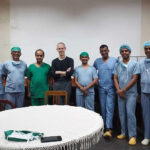Vascular rings: A complex cause of noisy breathing

Patients who present with noisy breathing, wheezing, a barking cough, and frequent respiratory infections are often misdiagnosed with asthma or croup, but a more complex problem could be responsible. Such symptoms can signal tracheomalacia (also known as tracheobronchomalacia), a condition in which the airway narrows or collapses when a child breathes.
But clinicians should consider the possibility of an additional concern, says Russell Jennings, MD, surgical director of the Esophageal and Airway Treatment (EAT) Center at Boston Children’s Hospital. Many children with tracheomalacia also have rare, abnormal formations of the blood vessels called vascular rings. These malformations can compress the trachea, esophagus, or both. While some vascular rings may never cause problems, others can trigger symptoms ranging from mild to life threatening — and require a comprehensive surgical approach.
A range of rings
In general, a vascular ring occurs when a child’s aorta or its branches form abnormally, so that it encircles and constricts the trachea and esophagus. One common type of vascular ring is the double aortic arch, in which a child is born with two aortic arches. The branches from these two aortic arches surround the trachea and esophagus.
In another type of vascular ring, called right aortic arch with aberrant subclavian and left ligamentum, the child’s aortic arch curves right and the left subclavian artery, which branches from the aortic arch, passes behind their esophagus and airway instead of in front of the airway. The ligamentum arteriosus (a blood vessel remnant) passes between the left subclavian artery and left pulmonary artery, completing the ring.
Beyond blood vessels
Not all patients with vascular rings require surgery and asymptomatic people may never realize that they have a vascular ring. More often, however, the condition causes a variety of respiratory and digestive symptoms, which occur when a vascular ring puts pressure on the esophagus, trachea, or both. Because few physicians are well versed in vascular rings, the symptoms they cause can go untreated or may be misdiagnosed as asthma or recurrent croup. “At Boston Children’s we are able to combine the specialties of cardiothoracic surgery with the EAT Center. Combining our experience with the vascular structures, and EAT’s experience with the esophagus, allows us to provide the best outcomes when operating in the posterior mediastinum.” says Christopher Baird, MD, a pediatric cardiac surgeon who performs these procedures with Jennings.
The gold standard of diagnosis
Pediatricians should refer patients for specialty testing if they exhibit any symptoms of a vascular ring, particularly noisy breathing. The gold standard for evaluating and identifying vascular rings is a computed tomography scan, says Jennings. This technique allows physicians to visualize the vascular anatomy properly. Vascular rings can be diagnosed at any age, including while a child is still in the womb.
Comprehensive surgical repair is key
Symptomatic patients with vascular rings usually require surgery to relieve pressure on the airway and esophagus. The most effective surgical approach involves a combination of procedures to move the aorta and any other blood vessels, as well as a complete resection of the diverticulum of Kommerell, which is typically left as an out-pouching of the aorta and compresses the esophagus and airway from the back. Surgeons may also treat tracheomalacia at this time. “Boston Children’s is the only hospital to address all of these problems in one comprehensive surgical repair,” explains Jennings. “Procedures that only treat one aspect of vascular rings typically require revision later on.”
Learn about the Esophageal and Airway Treatment Center.
Related Posts :
-

A surgeon’s last-minute trip to Sri Lanka reduces children’s wait for needed heart repair
Last year, Dr. Christopher Baird got an offer he couldn’t refuse — something that happens often as he travels the ...
-

The people and advancements behind 75 years of Boston Children’s Cardiology
Boston Children’s Department of Cardiology has more than 100 pediatric and adult cardiologists, over 40 clinical fellows learning the ...
-

After surgery for heart condition tetralogy of Fallot, James is all joy
Warriors come in all shapes and sizes. Some even smile. In the Irvine family, the lead warrior is a happy ...
-

Finding ways to reduce the financial and social costs of pacemakers
As the number of complex heart operations has increased over the years, so have cases of postoperative heart block, a ...





